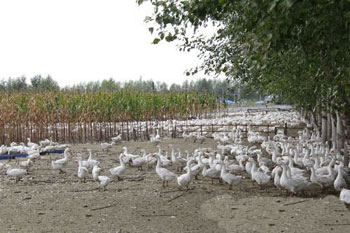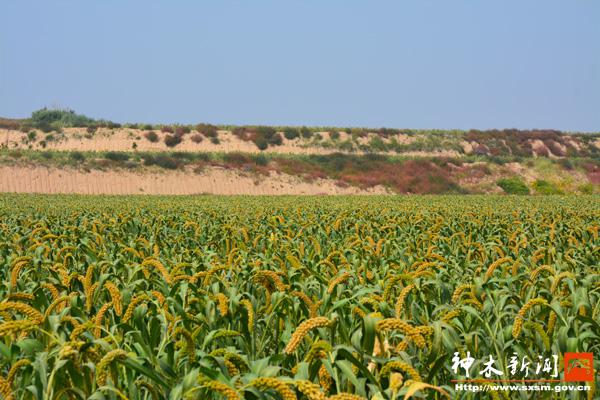Breeding big geese in cornfield, Heaven and Heaven, Heilongjiang and Renhe.

Bayi agricultural university breeding goose breeding base.
The goose path in the field.
On September 24, the reporter followed the science and technology service team of Heilongjiang Bayi Agricultural Reclamation University to the northern goose breeding farm in Datong District, Daqing City, which is the school's goose breeding demonstration base. According to Qin Zhiwei, president of Bayi Agricultural University, the focus of this visit is not on the new breeds of geese bred in the base, but on a new ecological breeding model.
A group of people came to a cornfield under the guidance of Zhou Ruijin, a researcher at Bayi Agricultural University. the cornfield in front of the reporter was very different from the nearby plot. The lower part of the corn stalk is completely bare, without a single leaf, the overall height is higher than other plots, the furrows and ridges are barbed wire, and the ground is surrounded by half-meter-high barbed wire. The most eye-catching is a large piece of white goose. With the arrival of the people, they quickly got into the corn bushes, like a white comb walking through the ridges, allowing people to chase and eat corn leaves at will. As if they were the owners of this territory.
"this is our new farming model, which is characterized by green, ecological and environmental protection." In the face of the reporter's surprise, Zhou Ruijin explained that there are more than 1000 geese in this field, using this method of natural stocking of corn fields.
Principal Qin Zhiwei skillfully took a tape measure to measure the height of goose feeding and corncob fruit. "the feeding height is close to 1 meter, and the fruiting height is 1.3 meters." He inserted the branches into the soil and compared the depth of the loose layer of the topsoil, saying, "the loose layer of the topsoil is 11 cm for stocking geese and 7 cm for unreleased geese." He pulled out the corn stalk but did not "shake" it. He turned to Zhou Ruijin to ask about the output of corn last year and the price of geese.
The reporter also observed that these big white geese are fat and strong, move quickly, and run very fast. according to the current situation of corn leaves being eaten, they can still reach the upper leaves by stretching their necks.
According to Zhou Ruijin, in 2010, the state introduced a policy of banning grazing. That year, after excluding captivity and woodland farming, he and his colleagues began to try to raise geese in silage, which achieved unexpected results that year. Through three years of experiment and popularization, the research group summarized the feeding and management norms related to the breeding model, such as feeding density, stocking age, growing season, stocking time, feeding time, concentrate feed, coarse feed and so on. technical norms for disease prevention and treatment of immune procedures, disease prevention, diagnosis and treatment of common goose diseases, as well as low-cost feeding techniques for the use of silage corn straw.
In 2013, Bayi Agricultural University began to implement the Ministry of Science and Technology Agricultural Science and Technology Transformation Fund Project "Integration and demonstration of low-cost Ecological Goose breeding techniques in Northern Cold regions". Three kinds of low-cost ecological breeding techniques for commercial geese are mainly promoted, such as "raising geese in corn field", "rotational grazing in family pasture" and "silage corn straw enclosure". In contrast, the effect of the former is the most significant.
The advantage of this "corn + goose" breeding and breeding model is that geese walk in the field to apply manure, increase soil fertility, and improve the soil into organic land for 3-5 years; geese eat old leaves and weeds of corn, increase ventilation in the corn field, and basically eliminate weeds and insect pests in the late growth stage of corn; geese eat corn fibrous roots, so that corn goes deeper into the soil, absorbs more nutrients, promotes higher plant growth, and fuller seeds. Corn and geese have become the raw materials of green organic food, and the straw is fed to the goose by silage fermentation after receipt, which can reduce the accumulation of straw after harvest, reduce the carbon emission of straw combustion and reduce environmental pollution, thus forming a virtuous cycle of eco-agricultural production mode.
The economic and ecological benefits brought by the "jade goose breeding model" can be summarized as "three decreases, two increases and one increase", that is, reducing the use of chemical fertilizers and pesticides, reducing carbon emissions from straw burning, reducing labor costs, and increasing the income of geese. Increased corn yield; improved corn quality and soil fertility. It not only avoids the industrial breeding with feed, but also solves the harm caused by pesticide and fertilizer residues to crops and land.
According to the statistics and determination of the research group for three consecutive years, every year, the direct economic benefits brought by goose farming reach 450-700 yuan per mu; corn increases by 5-10%, and the income per mu can be increased by about 100 yuan; in terms of chemical fertilizers, pesticides and labor, 20 yuan can be saved per mu; and 600kg is provided per mu. Since 2013, this breeding model has been popularized in Hongguang Farm and other places in Heilongjiang Reclamation area in the form of technical training, and has been widely praised by farmers.
- Prev

Huilong farmers introduce African ginseng fruit
Huilong farmers introduce African ginseng fruit
- Next

Yan Lanhu: returning to his hometown to start a "new farmer" to lead the villagers to become rich
Yan Lanhu: returning to his hometown to start a "new farmer" to lead the villagers to become rich
Related
- A course of planting techniques and methods on how to grow carrots
- How to plant the latest tulips?
- Is it better to pick tea in the morning or in the afternoon? When is the best time for tea to be picked? what is the third or fifth tea?
- Launch Yuanxiao Happy combination Haocha + Tea Yuan healthy Taste
- Penghu Tourism "Fireworks 20 Parade with You"
- 2022 West Lake Happiness holds "Digital Revitalization Voucher" and draws iphone13 and laptop.
- Banqiao Fuzhou social houses are designed to change start-up combined with police elimination to create a safe and livable environment
- The convenient measure of "mechanical weeding" in Xinbei has been abused and the Agriculture Bureau has imposed heavy penalties on the illegal land consolidation.
- Changgeng University Joins Hands with Four Memory Factories to Rescue Memory Talent Shortage
- The list of Taiwan's top 100 MVP managers is listed by the Director-General of the Farmers' Association of Sanxia District.

